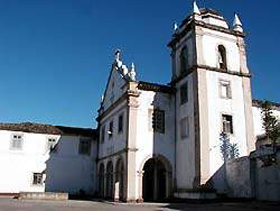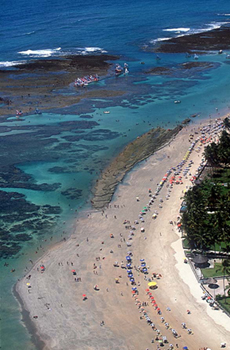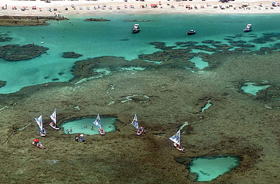|
|
Ipojuca - Pernambuco
«Recife
« Cities of Pernambuco
Population: 59.281 inhabitants
Distance from Recife: 57 km
Accesses: PE-60 e BR-101 (Cabo de Santo Agostinho route); double-laned as far as the Port of Suape; single lane from Suape to Porto de Galinhas. Visit maps of Recife and Pernambuco.
History
The name Ipojuca derives the Indian language tupi-guarani Iapajuque, wich means Dark Water.
The settlement of Ipojuca started in 1560, after the expelling of the Caetés indians and other tribes which inhabited the southern area of the Pernambuco coast. From that time, the farmers took over the fertile soil of massapê (kind of soil rich in organic and inorganic nutrients) of Ipojuca; the massapê and the propicious climate favoured the striving of the sugar cane in the region. Until today, large farms and mills occupy much of the land of Ipojuca.
 Ipojuca was one of the most important regions of Brazil during the colonial period. The city was a big producer of sugar. Two ports, Suape and Porto de Galinhas were built to export the production and import the slaves, necessary to keep the "engenhos" (ancient mills) working. Porto de Galinhas (Port of Hens) gained this name because Hens is the code by which the slaves were referred to during the period when their traffic was forbidden.
Ipojuca was one of the most important regions of Brazil during the colonial period. The city was a big producer of sugar. Two ports, Suape and Porto de Galinhas were built to export the production and import the slaves, necessary to keep the "engenhos" (ancient mills) working. Porto de Galinhas (Port of Hens) gained this name because Hens is the code by which the slaves were referred to during the period when their traffic was forbidden.
There are controversies about the date of foundation of Ipojuca; the most reliable sources refer to the year of 1596.
The municipal district of Ipojuca was created by the municipal law of number 02, from November 12th of 1895. The village was created with head offices in the village of Nossa Senhora do Ó, and afterwards was transfered to the village of São Miguel de Ipojuca.
By force of Decree 23, from October 4th of 1890, the head office was returned to Nossa Senhora do Ó.
Ipojuca is constituted by the head district and by the villages of Camela, Nossa Senhora do Ó, Porto de Galinhas, Praia do Touquinho and Suape.
Economy
 Because of the beaches (picture) visited by tourists from all around the world, tourism is one of the major economic activities of Ipojuca. The infrastructure of hotels and restaurants is constantly growing, to keep pace with the growing number of visitors.
Because of the beaches (picture) visited by tourists from all around the world, tourism is one of the major economic activities of Ipojuca. The infrastructure of hotels and restaurants is constantly growing, to keep pace with the growing number of visitors.
Ipojuca is also one of the biggest industrial clusters of Pernambuco, thanks to the many large industrial companies established there to take advantage of the facilities provided by the Porto de Suape. For example, in 2005 Petrobrás announced the construction of an oil refinery in Ipojuca, whose production will flow through Suape; this new project, along with the respective support projects, are certain to bring a significant boost to the economy of Ipojuca.
Even though not as strong as in the past, some cane farms still operate in Ipojuca, like this one. Not only the technology has developed, but also the production: whereas in the past the only product was white sugar (sent to Europe to replace the brown beet sugar), nowadays most of the cane is used to produce alcohol (etanol), utilized as fuel for Brazilian cars.
Ipojuca is located in the Metropolitan Region of Recife.
BesidesIpojuca, the Metropolitan Region comprehends the cities of Recife, Olinda, Jaboatão dos Guararapes, Abreu e Lima, Paulista, Igarassu, Itapissuma, Itamaracá, Cabo de Santo Agostinho, Camaragibe, São Lourenço da Mata, Araçoiaba and Moreno.
Tourism
Ipojuca is one of the postal cards of Pernambuco. Its paradisiac beaches, like Porto de Galinhas (picture), have been a constant presence in the list of the most beautiful and most visited beaches in Brazil. Both governments and private parties have been investing in the infrastructure of Ipojuca, to better serve more and more visitors.

Besides hotels and inns, there is a growing number of quality restaurants in Ipojuca.
As expected, fish and seafood are the basis of many restaurants; a tip is to taste "peixe na telha" (fish baked in a tile) with pitanga sauce. There are cuisines for all tastes in Porto de Galinhas, from the simplest broths and snacks to refined culinaries delicacies.
A buggy ride to the beach of Muro Alto is an unforgetable experience. So is the trip in "jangadas" (rustic wooden rafts) to the natural pools to watch the colorful fishes. By night, Porto de Galinhas offers one of the busiest nightlifes in the Brazilian northeast.
Heading south, visitors can see one of the beaches prefered by surfists, Maracaípe; a leg of the World Circuit happens here. Keep going south to find Serrambi, another beach of warm and clear waters.
Despite the quick growth observed in the recent years, the tropical scenery still predominates in Ipojuca. There are 18 kilometers of beaches, lined with a extense forest of coconut palms; special care is taken by enterprises and environment agencies to preserve the beautiness of the place.
Information source: IBGE and Government of the State of Pernambuco
| |